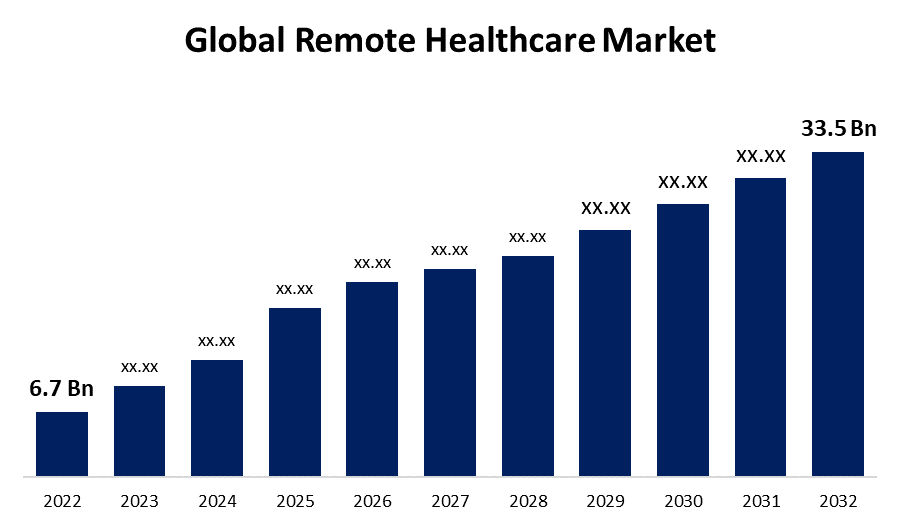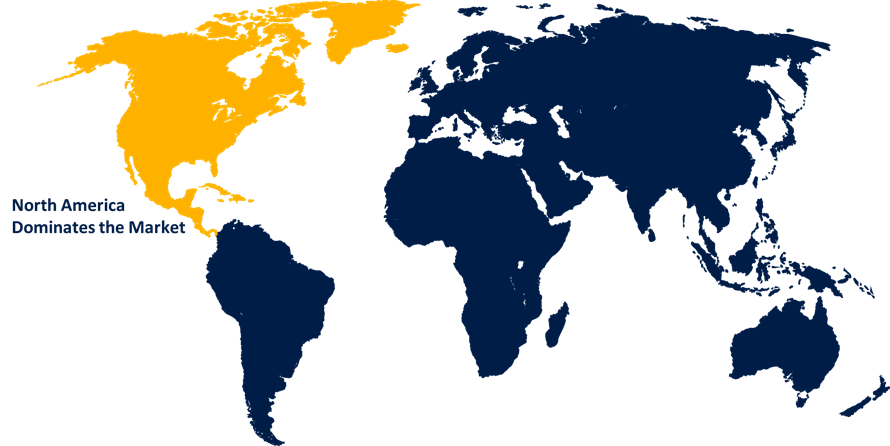Global Remote Healthcare Market Size, Share, and COVID-19 Impact Analysis, By Services (Remote Patient Monitoring, Real Time Virtual Health {Audio Communication, Video Communication, Email/Chat Box}, Tele-ICU), By End User (Payer, Provider {Hospitals, Clinics, Ambulatory Surgical Centers, Other Providers}, Patient), By Region (North America, Europe, Asia-Pacific, Latin America, Middle East, and Africa), Analysis and Forecast 2022 - 2032.
Industry: HealthcareGlobal Remote Healthcare Market Size Insights Forecasts to 2032
- The Global Remote Healthcare Market Size was valued at USD 6.7 Billion in 2022.
- The Market is Growing at a CAGR of 17.46% from 2022 to 2032.
- The Worldwide Remote Healthcare Market Size is expected to reach USD 33.5 Billion by 2032.
- Asia Pacific is expected to grow the fastest during the forecast period.

Get more details on this report -
The Global Remote Healthcare Market Size is expected to reach USD 33.5 Billion by 2032, at a CAGR of 17.46% during the forecast period 2022 to 2032.
Market Overview
Technology improvements such as increased internet access, mobile devices, and remote monitoring tools have permitted the growing use of remote healthcare services. Changes in healthcare rules and regulations have also aided the spread of telemedicine services and enhanced compensation for remote treatment. Remote healthcare is a healthcare delivery approach that allows patients to obtain medical treatments and consultations from healthcare experts via video conferencing, audio communication, and digital communication technologies. This technique enables individuals to effortlessly receive healthcare services regardless of their geographic location and reduces the necessity for in-person visits to medical institutions. In addition, the remote healthcare industry has proved especially advantageous for rural people, where access to specialist healthcare services might be difficult. Telemedicine, according to research published in the Journal of the American Medical Informatics Association, considerably decreased patient travel time and expenses for rural people, resulting in a higher chance of receiving medical care.
Report Coverage
This research report categorizes the global Remote Healthcare Market based on various segments and regions and forecasts revenue growth and analyses trends in each submarket. The report analyses the key growth drivers, opportunities, and challenges influencing the global Remote Healthcare Market. Recent market developments and competitive strategies such as expansion, product launch, and development, partnership, merger, and acquisition have been included to draw the competitive landscape in the market. The report strategically identifies and profiles the key market players and analyses their core competencies in each sub-segment of the global Remote Healthcare Market. Technological innovation and advancement will further optimize the performance of the product, enabling it to acquire a wider range of applications in the downstream market.
Global Remote Healthcare Market Report Coverage
| Report Coverage | Details |
|---|---|
| Base Year: | 2022 |
| Market Size in 2022: | USD 6.7 Billion |
| Forecast Period: | 2022-2032 |
| Forecast Period CAGR 2022-2032 : | 17.46% |
| 2032 Value Projection: | USD 33.5 Billion |
| Historical Data for: | 2018-2021 |
| No. of Pages: | 200 |
| Tables, Charts & Figures: | 120 |
| Segments covered: | By Services, By End User, By Region and COVID-19 Impact Analysis. |
| Companies covered:: | Advanced ICU Care, BioTelemetry, Koninklijke Philips, Teladoc Health, Vivify Health, AirStrip Technologies, Medtronic, InTouch Technologies, American Well, Resideo Life Care Solutions and other key venders. |
| Pitfalls & Challenges: | COVID-19 Empact, Challenge, Future, Growth, & Analysis |
Get more details on this report -
Driving Factors
The global market is expected to be driven by the increasing usage of smartphones, mHealth apps, wearable technologies, and digital healthcare. Also, a rising number of investments in the remote healthcare business are fueling segment expansion. Moreover, the increased deployment of virtual care platforms is likely to improve remote healthcare business profit. With the advent of telehealth services and digital health solutions, consumers and healthcare professionals are embracing the ease and accessibility that virtual care provides. These technologies provide seamless remote consultations, remote monitoring, and health data management, making healthcare services more accessible and efficient for patients while enhancing healthcare providers' operations. Furthermore, the COVID-19 epidemic has hastened the acceptance and integration of these virtual care platforms, since they give a safe alternative to in-person appointments.
Restraining Factors
Security and privacy concerns can hamper the growth of the remote healthcare sector. With the increased use of virtual care platforms and telehealth services, there has been a rise in data breaches and illegal access to sensitive patient information. Furthermore, using telemedicine solutions without adequate security may result in massive losses of personal and crucial information.
Market Segmentation
- In 2022, the remote patient monitoring segment is dominating the largest market share over the forecast period.
Based on services, the global remote healthcare market is bifurcated into different segments such as remote patient monitoring, real time virtual health {audio communication, video communication, email/chat box}, and tele-ICU. Among these segments, the remote patient monitoring segment segment is expected to have significant development potential during the forecast period. Remote patient monitoring enables healthcare practitioners to remotely monitor their patient's health problems and vital signs, allowing for proactive and individualized care. Individuals may actively participate in controlling their health, which increases patient involvement and empowerment. Remote patient monitoring also offers early detection of health concerns, allowing for prompt treatments and lowering the need for hospital readmissions. Furthermore, improved data gathering and real-time access to patient information enable healthcare providers to make better-informed decisions.
- In 2022, the provider segment is influencing the market with the largest market share during the forecast period.
Based on the end user, the global remote healthcare market is segmented into various types such as payer, provider {hospitals, clinics, ambulatory surgical centers, other providers}, and patient. Among these segments, the provider segment is dominating the market with the largest revenue share during the forecast period. The growing use of telehealth services and virtual care platforms allows healthcare practitioners to give their patients easy and accessible healthcare solutions. rural consultations and virtual visits enable healthcare practitioners to reach out to patients in rural or underserved locations. It simplifies healthcare processes, increasing efficiency and lowering administrative burdens. Furthermore, remote healthcare promotes higher patient participation and adherence to treatment protocols, resulting in better patient outcomes. In addition, by adding remote healthcare into their service offerings, healthcare providers may improve resource allocation and save expenses.
Regional Segment Analysis of the Remote Healthcare Market
- North America (U.S., Canada, Mexico)
- Europe (Germany, France, U.K., Italy, Spain, Rest of Europe)
- Asia-Pacific (China, Japan, India, Rest of APAC)
- South America (Brazil and the Rest of South America)
- The Middle East and Africa (UAE, South Africa, Rest of MEA)
North America led the market with the largest market share during the forecast period

Get more details on this report -
North America is influencing significant market growth over the forecast period due to rising healthcare expenditures, along with the introduction of innovative technology for the effective operation of healthcare organizations, which are driving sector growth. more disposable money, more awareness, and a desire for better healthcare services are also important drivers driving the industry forward. Furthermore, the growing frequency of chronic illnesses, along with an aging population, has increased demand for remote healthcare services capable of providing continuous monitoring and individualized care.
Asia Pacific is expected to experience high revenue market growth during the forecast period owing to Initiatives by governmental and corporate agencies, such as awareness initiatives, collaborations, and R&D financing, which are expected to expand the market in the region.
Competitive Analysis
The report offers the appropriate analysis of the key organizations/companies involved within the global Remote Healthcare Market along with a comparative evaluation primarily based on their product offering, business overviews, geographic presence, enterprise strategies, segment market share, and SWOT analysis. The report also provides an elaborative analysis focusing on the current news and developments of the companies, which includes product development, innovations, joint ventures, partnerships, mergers & acquisitions, strategic alliances, and others. This allows for the evaluation of the overall competition within the market.
List of Key Companies
- Advanced ICU Care
- BioTelemetry
- Koninklijke Philips
- Teladoc Health
- Vivify Health
- AirStrip Technologies
- Medtronic
- InTouch Technologies
- American Well
- Resideo Life Care Solutions
Key Target Audience
- Market Players
- Investors
- End-users
- Government Authorities
- Consulting And Research Firm
- Venture capitalists
- Value-Added Resellers (VARs)
Recent Development
- In December 2021, GlobalMed announced the addition of new virtual care delivery service options to the CostSimplified program, which allows organizations to adopt and provide access to users of virtual health stations, devices, and software platforms for a low monthly fee. This method will increase patient access while increasing income for the corporation.
- In March 2022, Microsoft Corp. announced new cloud technology developments for the healthcare and life sciences industries. The widespread release of Azure Health Data Services and substantial enhancements to the Microsoft Cloud for Healthcare were among these accomplishments.
Market Segment
This study forecasts revenue at global, regional, and country levels from 2022 to 2032. Spherical Insights has segmented the Global Remote Healthcare Market based on the below-mentioned segments:
Global Remote Healthcare Market, By Services
- Remote Patient Monitoring
- Real Time Virtual Health {Audio Communication, Video Communication, Email/Chat Box}
- Tele-ICU
Global Remote Healthcare Market, By End User
- Payer
- Provider {Hospitals, Clinics, Ambulatory Surgical Centers, Other Providers}
- Patient
Global Remote Healthcare Market Market, By Regional Analysis
- North America
- US
- Canada
- Mexico
- Europe
- Germany
- Uk
- France
- Italy
- Spain
- Russia
- Rest of Europe
- Asia Pacific
- China
- Japan
- India
- South Korea
- Australia
- Rest of Asia Pacific
- South America
- Brazil
- Argentina
- Rest of South America
- Middle East & Africa
- UAE
- Saudi Arabia
- Qatar
- South Africa
- Rest of the Middle East & Africa
Need help to buy this report?